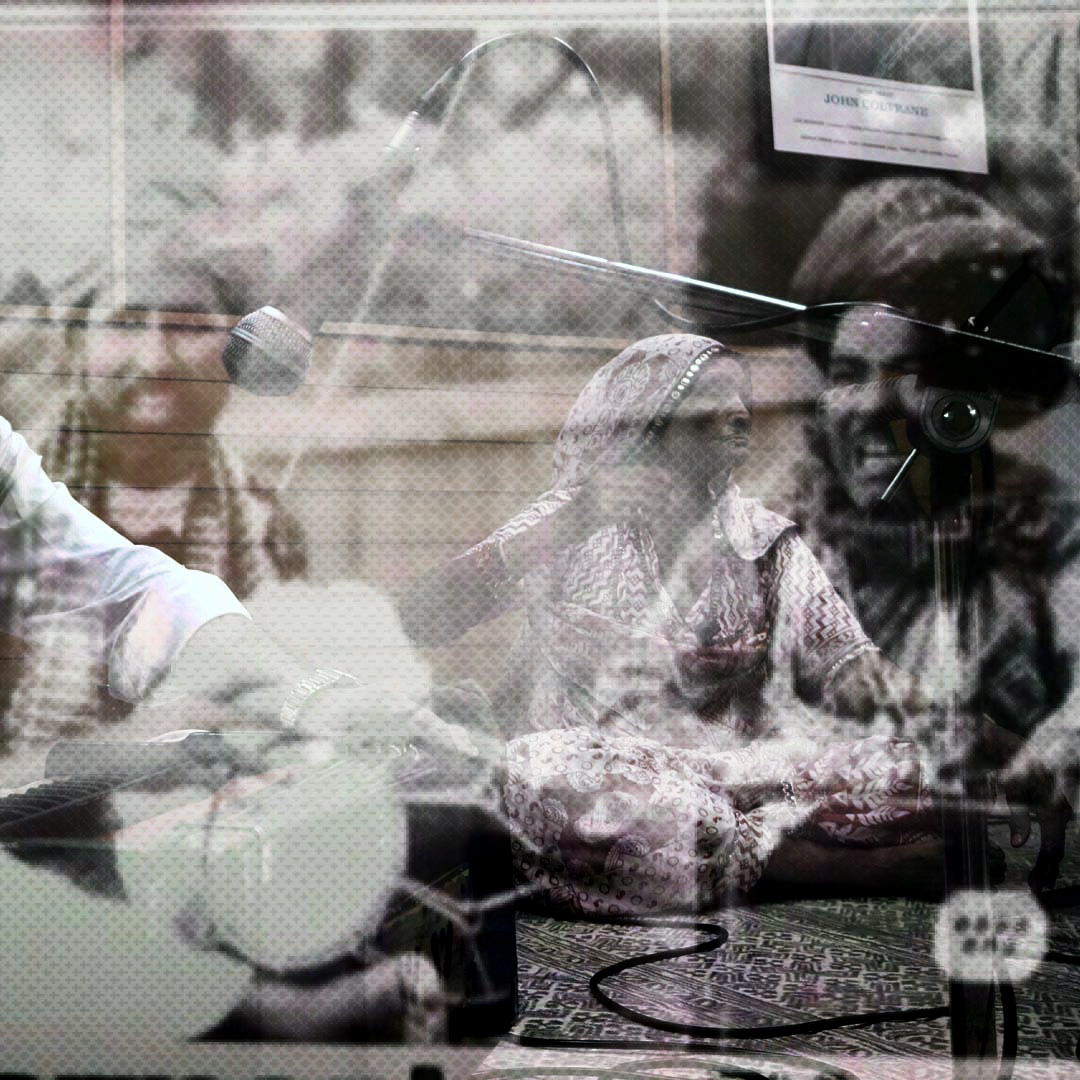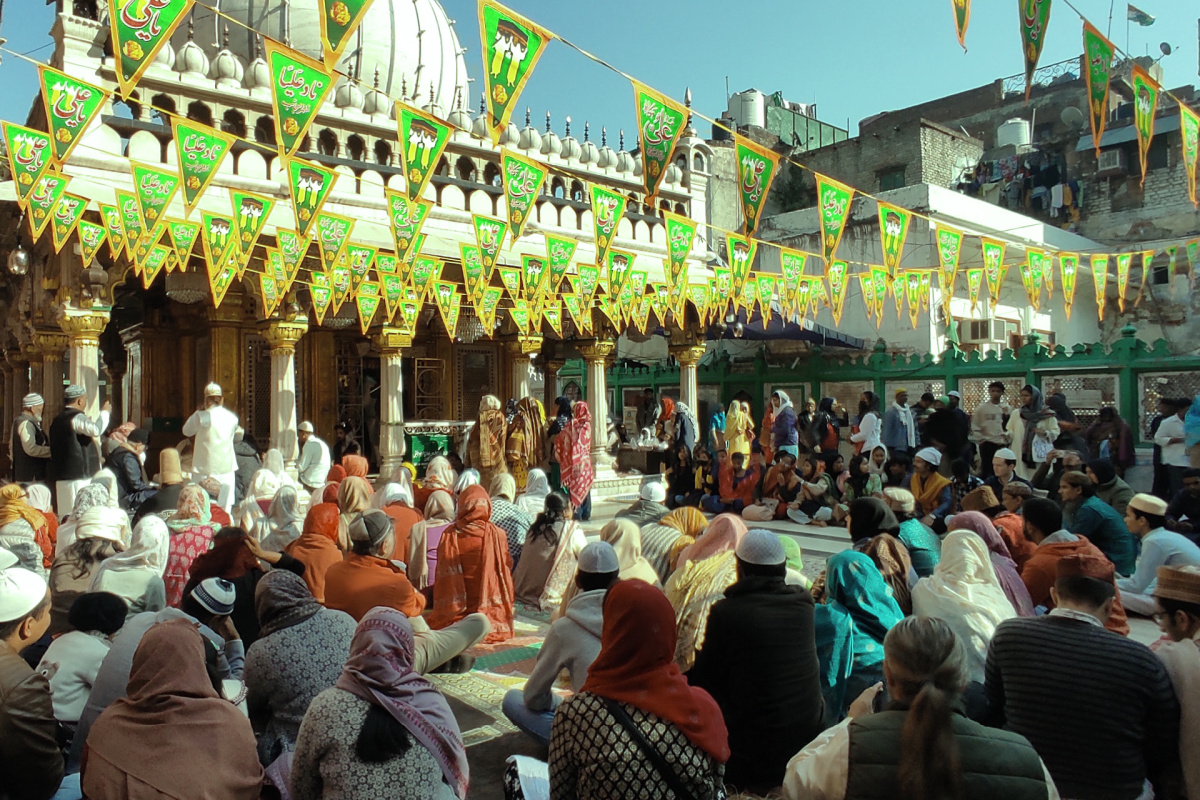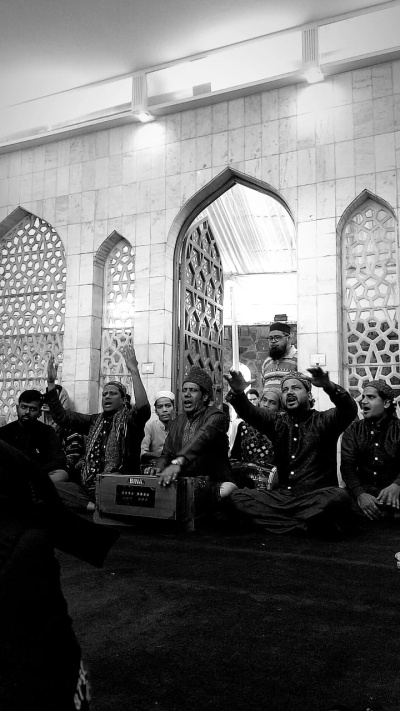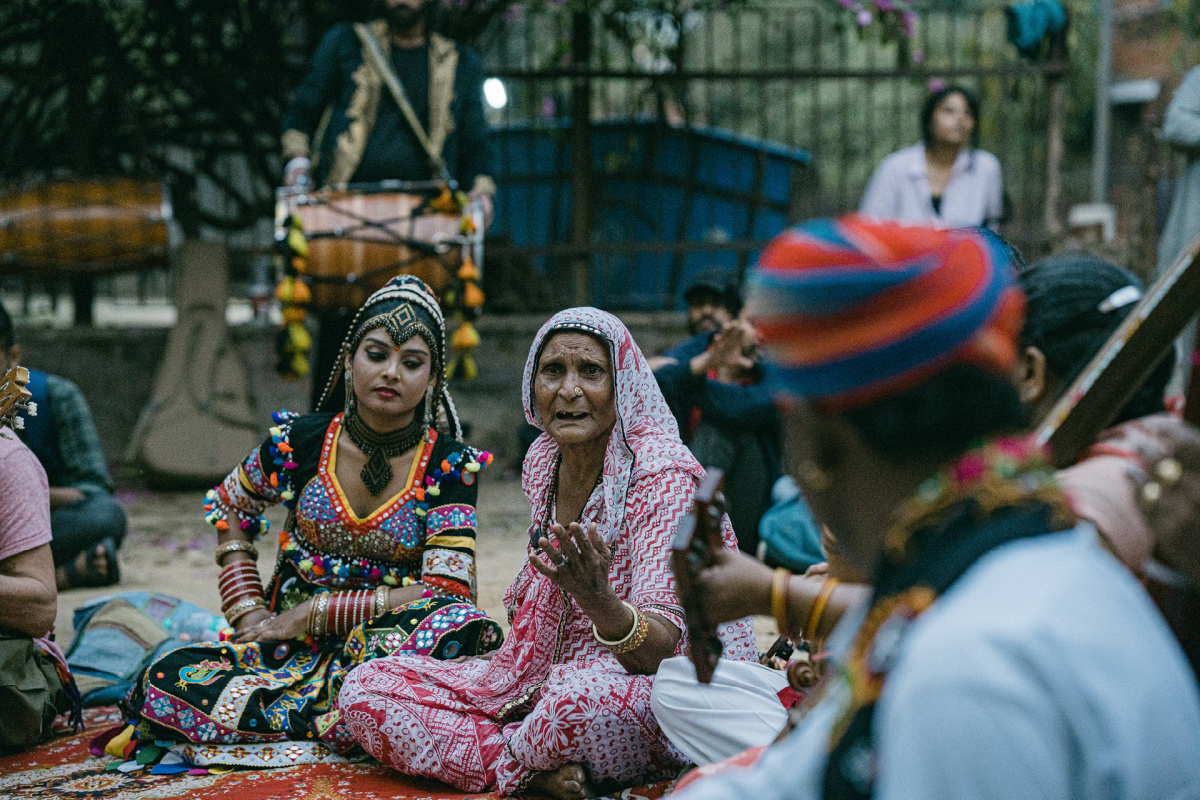
In the Concrete Jungle
Sunayana Wadhawan traces a map of events, stories, songs, and movements in New Delhi that foreground the effects of urban redevelopment on arts and heritage in the city. Featuring artists from diverse communities and art forms, the article highlights the systemic marginalization, displacement, and invisibilizing of folk and indigenous practices. Meanwhile, the artists continue to resist the undermining conditions and find creative and tactical ways to sustain their artistic forms and desires.
The Delhi Master Plan is a legal document that defines norms for land use, basic amenities, and space allocation for arts and heritage. Delhi now also has an Art Master Plan which has been put together by the Delhi Urban Art Commission (DUAC) to provide guidance on promoting art in public spaces.1 However, the reality on the ground is in stark contrast to what is projected on paper. Apart from the usual clubs and cultural venues in Delhi, all one finds is the persistent rise of elite cultural centers owned by industrialist families that are aiming to celebrate art while alienating the public and street art from spaces they occupy in the city.
Kathputli Colony
It is in this context that the story of Kathputli Colony (translated to Puppeteer’s Colony) becomes crucial when tracing a map of the artists and art forms that are displaced and delegitimized in the name of development. Kathputli Colony, near the Shadipur bus depot in central Delhi, famously known as «the largest community of street performers» became home to over 12 artist communities including puppeteers, magicians, musicians, singers, dancers, acrobats, sculptors, craftsmen, and artisans from Rajasthan from the late 1950s. Many of them belonged to the denotified tribes like Nat, Bhatt, Madari, and Baghari, communities who had settled in Delhi as demand for their work increased post-independence.
Their patrons began to expand beyond the feudal ones back in their villages, more with politicians, art enthusiasts, and tourists who were also instrumental in promoting Indian art and culture in Europe and America. The nature of their profession meant frequent traveling for performances and the need for public transport. The folk artists of Kathputli Colony have traveled to over 80 countries representing India with their art forms, won prestigious national awards, and participated in several national and international festivals, Republic Day parades, and social awareness campaigns. Over the years, such opportunities have reduced and folk artists find themselves without secure homes, relying mostly on private events and the wedding season to ensure they earn something to sustain their families.
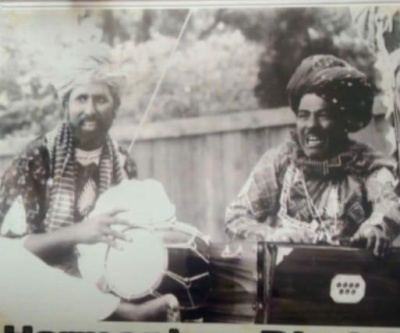
Collective Worlds
Kesri Devi, 90, a folk singer from the Nat-Bhat community, was one of the many artists who was concerned about the future of her children and their livelihoods. She came to Kathputli Colony at a young age when she got married to Mohan Bhat, a renowned puppeteer. She recalls the thrill of running away from home as a child every time she heard the sounds of singing and live music in her village to fulfill her heart’s desire to learn how to sing. Along with being proud of her cultural heritage, she celebrates her voice and her renditions of traditional folk songs that she has kept safe in her treasure of memories, which she has sung for All India Radio, and while accompanying her husband during puppet shows.
Kesri Devi, Goru Bhatt, and friends singing folk songs on a rooftop in Kathputli Colony before it was demolished, 2014 (video: Sunayana Wadhawan).
Kathputli Colony too was like her village where artists came together and sang, where young children practiced percussion on dhols, tashas, and even buckets, and watched the elders of their community get ready for work or craft musical instruments and more. Over the years, migrant workers from several states of India found shelter here, leading to a flourishing exchange of work, culture, and common aspirations among the different communities that created a unique cultural economy in the heart of the city of Delhi. Ironically, it also became a tourist spot promoted by luxury hotels like Hyatt Regency.
A jam by percussionists on Kathputli Colony streets, 2014 (video: Sunayana Wadhawan).
Displacement in the Name of Urban Redevelopment
The artists and migrant worker families of Kathputli Colony appealed to politicians and government authorities for a dignified life and land rights in the city for many years, but in 2009, they found themselves surrounded by uncertainties with the news of a public–private partnership to redevelop Kathputli Colony. The Delhi Development Authority signed a contract with a private developer to construct 2800 multi-story flats for the residents of Kathputli Colony while giving the developer rights over the land to also build luxury apartments and a shopping mall. There were questions that needed answers: why only 2800 flats when there were many more families who resided in Kathputli Colony? Why not land rights, especially when multi-story housing is not suitable for their arts and livelihoods, and most importantly, why were all these plans made without the consent of those being affected by the project?
The residents were in the process of building a collective understanding of the existing policies and their entitlements, when I, along with a team of social workers from community-based organizations that had been seeking accountability for evictions and lack of housing for migrant workers in the city, began to support community-led documentation and accountability-building efforts.
Callous Encounters, Violent Evictions
These questions were also taken to court in search of justice by the Bhule Bhisre Kalakaar co-operative industrial society (translated as the Forgotten Artists co-operative) that was formed in 1978 by the artists of Kathputli Colony with the support of an NGO. There were powerful expressions of protest by the artist-residents during protests and public meetings to engage with the authorities and the media for accountability and inclusive decision-making.
The DUAC also had reservations about the project, which were on record, but 5.2 hectares of land in the center of the city appeared to be more precious to policymakers and private developers than the cultural heritage and homes that had been built by generations of folk artists and migrant workers in the city. The artists were accused of being «slum mafia», threatened with violence and surrounded by police forces to evict them and silence their collective efforts to save their homes and their livelihoods. In 2017, while they were demanding survey lists of families included in the redevelopment scheme, the DDA began a demolition drive with police personnel helping them clear the way for bulldozers by brutally attacking the protesting residents.
Systemic Failures
It has been almost six years since the evictions when 2800 families of over 4000 families of Kathputli Colony were shifted to temporary shelters in transit camps, while others were scattered on the outskirts of Delhi or rendered homeless and living around the streets, flyovers, and parks surrounding Kathputli Colony.
Kesri Devi has been living at the transit camp in Anand Parbat (an area in Central Delhi), where she has witnessed the loss of loved ones amidst the lack of work, adequate basic services, the horrors of fires breaking out, and the recent pandemic. Although artists like her have not given up on their art forms, the conditions are far from being conducive to promoting and protecting them.
The artists worry about the lack of opportunities for their children as well as the future of their art traditions. Increased unemployment, lack of space and resources, and rising cases of violence are making it more difficult for young artists to learn and practice art forms with the older generations of artists. Their work is seasonal, and the struggle to find work is only getting tougher. Street performers face harassment for trying to perform in public spaces even though the laws of the land have gone through changes. Even though arts and culture are critical to sustaining communities, those who are at the heart of practicing them are facing exclusion in the capital of India.
Resistance, Resilience, and Rebuilding
I have been learning endlessly from the Kathputli Colony about the struggle of folk artists to be able to work and create art amidst fears of eviction. The sight of a group of percussionists leaving their elders and children behind to guard their belongings and head to work in their bright costumes on the day that their homes were being demolished and turned into debris reveals who is truly trying to keep the arts alive in this country and who is ruthlessly destroying it.
The younger artists, amidst the displacement, have been going against all odds to begin recrafting their art forms, from becoming dhol players, especially for wedding processions, to redesigning their musical instruments, creating educational puppets, musical groups integrating Western instruments and collaborating with DJs, turning to online platforms, and even changing the objects used in their magic tricks to speak more to the times we live in.
During the COVID-19 pandemic, spaces and opportunities for artists were starkly reduced for folk artists in Kathputli Colony and other parts of the country, whereas privileged artists went live and «viral» on online platforms like YouTube. A few efforts to support folk artists in rural and urban areas through online charity shows and art workshops also did not succeed due to the lack of internet connectivity and access to technology.
To understand and bridge the increasing gap and invisibilization of folk artists from digital spaces and support their search for resources while they were stuck in their homes without work, I began facilitating folk artists, mostly in North India, to create their own music recordings to share their works on independent and artist-owned YouTube channels. This way they could also own rights to their works and question the continuing appropriation of their work.
Artists Navigating the Terrain
From Talb Khan in Barmer, Rajasthan, to Geeta Parag in Dewas, Madhya Pradesh, to the Milaap Kalakaar collective of artists in Punjab, and more recently, folk musicians like Kesri Devi from Kathputli Colony, it has been a journey full of moments of learning, economic empowerment and recognition, and full of questions around technology and devices; how contemporary laws, practices and digital cultural economies are shaping art, its value, ownership, and community rights. These efforts do not address the lack of accountability and continuing injustices folk artists are facing, but have made some room for discussions on fair practices and wages, making technology accessible, and the importance of strengthening livelihood opportunities.
Sound engineers and recording artists from Delhi aware of these recurring challenges also joined us to address the technical challenges of recording live performances in their villages or in home concerts. We have also encouraged artists to find studios in their region to sustain their efforts to record and share their work. These hopeful steps were also supported by a few legal experts and artists from different parts of the country.
One constant source of support and inspiration has been folk singer and social activist, Prahlad Tipaniya, who continues to question and address the discrimination, invisibilization, and appropriation that artists like him encounter in their journeys. His team has set a strong example of how folk artists can also reclaim their space on platforms like YouTube and in live music events.2
There are signs of an active audience present on online platforms that folk artists, folk musicians, and dancers can find from their regions and beyond. It is through this demand for folk art, and accessible platforms like YouTube for audiences to participate in, that online platforms are slowly becoming a source of income for folk artists. This effect also extends to not just folk artists receiving a few more work opportunities but also those integrating contemporary music forms into their lives.
PP Rapstar, a young rapper from Kathputli Colony, has been writing songs in the last few years to claim his rightful space in the city and the music scenes. His music is strongly influenced by hip hop and reflects his strong refusal to submit to a system that is driven by money to oppress the futures of young people like him. While some may feel he is moving away from his traditional art forms, maybe we should see it the other way round; that the system is making him speak a different language of art in the city, that he is opting out of a system where artists of his community are exploited and still expected to adhere to casteist cultural norms and not given the respect every artist and every citizen deserves in this country.
Deepak Mady and Aijaz from Seemapuri, a locality in Northeast Delhi, released a song with Jamnapaar Records, «Ta Ta Thayi», which calls out people who judge rappers like him and the neighborhoods they belong to. They question classist and communal politics that deny access to youngsters like him. In their song, they also declare that the era of labels is over and the youth are embracing independent culture.
A few years ago, I worked with young women who are children of evicted families rehabilitated in flood-prone resettlement colonies of Delhi like Madanpur Khadar. They were not trained in any particular art form, but chose to write about their experiences of the city through a Hindi hip hop slam song. The group often saw only young boys in their neighborhood getting into hip hop and rap. They decided they wanted to learn about these genres and make songs to express themselves creatively. «Khadar ki ladkiyaan» maps the journeys of the women from evictions to the increased struggles around education, livelihoods, and safety, which they confront with their fearless voices.
Rocksan is another young rapper and singer residing in Jai Hind Camp of South Delhi whose song «Basti mein masti» speaks of the contradictions in the aspirations of those living in his settlement while they all seek certainty in the form of a secure space to live and go to work. Rocksan, unlike PP Rapstar, is not from an artist community. He works the night shift in the informal sector and spends the daytime working on his music and his dreams to become a full-time musician. He chooses to write about what exists in his reality and does not agree with the idea of pretending to be someone else to appear cool and attractive to the audience. In a recent conversation, he said, «I write the truth in my songs. If I am riding a bicycle, I will write about the bicycle. I won’t write about driving around in a car… I’ll do that when I have my own car.» At the same time, he reports the lack of access to resources for an artist like him to record his songs. He misses the days when his neighbor, who worked as a helper at a music studio, learned the basics of music software and supported Rocksan with his recordings at Jai Hind Camp.
Knots and Tangles that Remain
Whether it is practicing art and access to space and resources, or fighting for basic necessities like water, healthcare, housing, or even studios, our city tends to make many artists feel ignored and disproportionately represented. It was a demand for space in the city for artists to live, learn, interact, and create art, for music groups to practice, for puppeteers to make larger-than-life puppets, for acrobats to walk on their stilts and practice their art, etc., that the artists had appealed to governmental authorities and courts to review the plans made for redeveloping Kathputli Colony and shifting their families into tiny multi-story flats without their participation or consent. The city houses art in big museums and galleries today, but it fails to provide homes and spaces for work to many artists. The question is: why are certain artists marginalized in the city while others thrive? What are the forms of art that are able to flourish while others struggle to survive? Is it the lack of inclusive policies, participatory planning, and meaningful promotion of arts, or is it the privilege of wealthier artists and audiences that are defining the way art is celebrated in the city? What do the «forgotten artists» want us to remember?
Kesri Devi on her desire to learn music and how she picked up various musical forms and instruments in her youth despite all odds (video: Geetanjali Kalta).
Kesri Devi calls out the greed and disregard for humanity that destroyed her neighborhood and hopes that artist communities can live and work together someday to share the cultural knowledge they embody with future generations so that young girls aspiring to be singers like her can follow their hearts as she did. What is our responsibility towards her hopes turning into certainty? How do we ensure artists and their voices are given the space, respect, recognition, and resources they deserve? Not just in the digital world, but in our social and lived realities?
- 1. Dilli Haat, a popular landmark for folk arts and handicrafts in Delhi, is a rare example of public land being dedicated to arts and culture and promoting artist livelihoods (this has its own share of complexities), which is a discussion for another time.
- 2. Folk singer and social activist, Prahlad Tipaniya, who sings the works of poets and social reformers like Kabir, Meera Bai, Sant Ravidas to engage with his audience on themes of self-awareness, equality, and communal harmony, has also questioned the appropriation of folk music traditions and unfair practices. His team has set a strong example of how folk artists can reclaim their space on platforms like YouTube and in live music events, while supporting several local folk artists with their efforts to connect with larger audiences.
This essay is part of the virtual exhibition «Norient City Sounds: Delhi», curated and edited by Suvani Suri.
Project Assistance: Geetanjali Kalta
Graphics/Visual Design: Upendra Vaddadi, Neelansh Mittra
Audio Production: Abhishek Mathur
Video Production: Ammar
Biography
Shop

Published on September 29, 2023
Last updated on February 21, 2024
Topics
How does this ideology, but also its sheer physical expressions such as labor affect cultural production? From hip hop’s «bling» culture to critical evaluations of cultural funding.
Why do people in Karachi yell rather than talk and how does the sound of Dakar or Luanda affect music production?
Digitization means empowerment: for niche musicians, queer artists and native aliens that connect online to create safe spaces.
About Tunisian rappers risking their life to criticize politics and musicians affirming 21st century misery in order to push it into its dissolution.
How does the artits’ relationship to the gear affect music? How to make the climate change audible?
From westernized hip hop in Bhutan to the instrumentalization of «lusofonia» by Portuguese cultural politics.
Special
Snap
